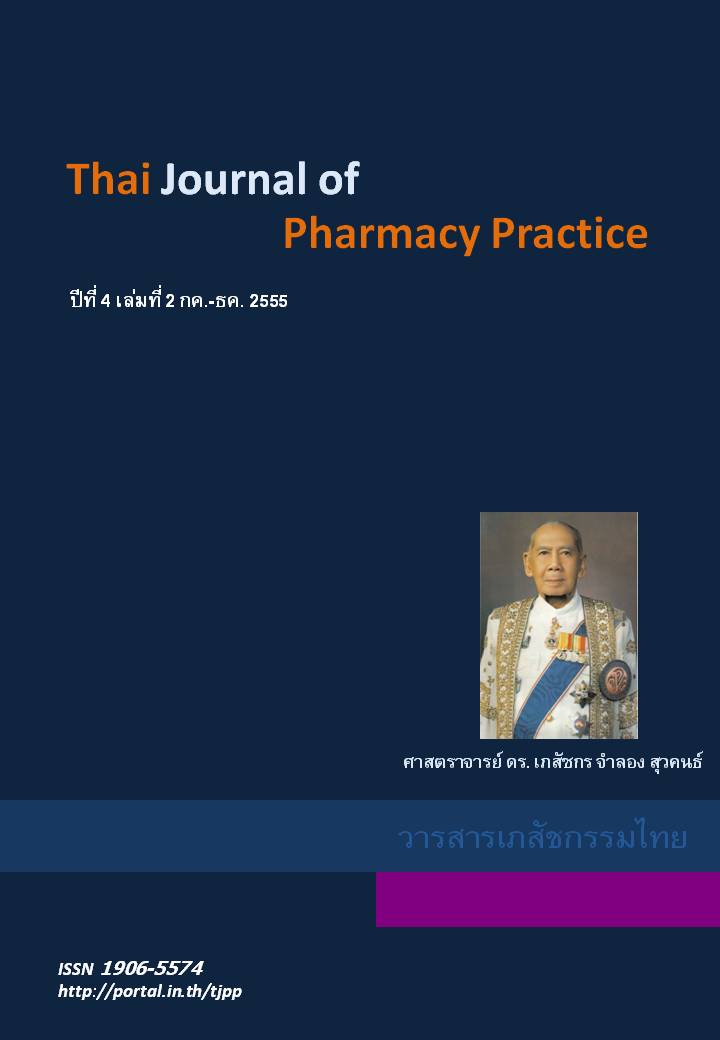Pharmacy Professionalism among Thai Pharmacy Students
Main Article Content
Abstract
Objective: To survey the level of pharmacy professionalism, and to analyze the relationship between professional socialization and pharmacy professionalism among Thai pharmacy students. Methods: Self-administered questionnaires were used as the research instrument. Face validity was assessed by three experts. A pilot study was conducted on 61 pharmacy students. Cronbach’s alpha coefficient was used as the measure of instrument reliability. The questionnaires were disseminated to pharmacy students throughout the country between July 2010 and May 2011. Multiple regression was utilized to analyze the relationship between professional socialization and pharmacy professionalism. The level of significance was set at 0.05. Results: A total of 1,443 usable questionnaires were received (57.7% response rate). The overall pharmacy professional scores among students was 171.1±14.9 from the possible scores of 42-210, indicating moderate to high professionalism level. The highest score was found in “belief in public service” domain, followed by “belief in continuing education”, “the use of professional organization as a major referent”, “belief in self-regulation”, “belief in autonomy” and “professional commitment” with the lowest score. Professional socialization was positively correlated with overall pharmacy professionalism (r=0.585, p<0.001). Interaction with preceptors, interaction with peers, out-of-classroom interaction with faculty, perception about faculty concerns, and academic and social growth together accounted for 35.4% of the variability in overall pharmacy professionalism. Conclusion: Thai pharmacy students scored highest in belief in public service domain, compared to other domain of pharmacy professionalism. Professional commitment, on the contrary, was scored the least. Professional socialization was a very important predictor of pharmacy professionalism among students. For this reason, pharmacy schools are recommended to place emphasis on such process, along with formal education according to the curriculum.
Article Details
ผลการวิจัยและความคิดเห็นที่ปรากฏในบทความถือเป็นความคิดเห็นและอยู่ในความรับผิดชอบของผู้นิพนธ์ มิใช่ความเห็นหรือความรับผิดชอบของกองบรรณาธิการ หรือคณะเภสัชศาสตร์ มหาวิทยาลัยสงขลานครินทร์ ทั้งนี้ไม่รวมความผิดพลาดอันเกิดจากการพิมพ์ บทความที่ได้รับการเผยแพร่โดยวารสารเภสัชกรรมไทยถือเป็นสิทธิ์ของวารสารฯ
References
2. Kerr S, von Glinow MA, Schiesheim J. Issues in the study of professionals in organization: the case of scientists and engineers. Organ Behav Hum Perf 1977;18:329-45.
3. Bartol KM. Professionalism as a predictor of organizational commitment, role stress, and turnover: a multidimensional approach. Acad Manage J 1979;22:815-21.
4. Snizek WE. Hall’s professionalism scale: an empirical reassessment. Am Sociol Rev 1972;37:109-14.
5. Hammer DP. Professional attitudes and behavior: the “A’s and B’s” of professionalism. Am J Pharm Educ 2000;64:455-64.
6. Anderson DJ. The hidden curriculum. AJR 1992;159:21-2.
7. Karnieli-Miller O, Vu R, Holtman MC, Clyman SG, Inui TS. Medical students’ professionalism narratives: a window on the informal and hidden curriculum. Acad Med 2010;85:124-33.
8. Chaichalermpong W. Factors affecting learning outcomes from hidden curriculum which influence professionalism of pharmacy students [dissertation]. Bangkok: Chulalongkorn University; 2004.
9. American College of Clinical Pharmacy. ACCP white paper: development of student professionalism. Pharmacotherapy 2009;29:749-56.
10. Lerkiatbundit S. Professionalism in Thai pharmacy students. J Soc Admin Pharm 2000;17:51-8.
11. Ploylearmsang C, Satayavongthip B, Suttajit S, Arpasrithongsakul S. Students’ professionalism and leadership influenced by pharmacy education and institutional socialization. Isan Journal of Pharmaceutical Sciences 2006;2:1-12.
12. Lerkiatbundit S. Factor structure and cross-validation of a professionalism scale in pharmacy students. Journal of Pharmacy Teaching 2005;12:25-49.
13. The Pharmacy Council regulation on pharmacy curriculum and certificate, or pharmacy profession diploma of various institutions for the purpose of membership application of 2551 B.E. Government Gazette. No 125 Special Section 67 D. 3 April 2008.
14. Bartlett JE, Kotrlik JW, Higgins CC. Organizational research: determining appropriate sample size in survey research. Information Technology, Learning, and Performance Journal 2001;19:43-50.
15. Cohen J. Statistical power analysis for the behavioral sciences. 2nd ed. Hillsdale, NJ: Lawrence Erlbaum; 1998.
16. Blau GJ. Further exploring the meaning and measurement of career commitment. J Voc Beh 1988;32:284-97.
17. Fjortoft NF, Lee MWL. Developing and testing a model of professional commitment. Am J Pharm Educ 1994;58:370-8.
18. Manesse HR, Stewart JE, Hall RH. Inconsistent socialization in pharmacy—a pattern in need of change. In: Wetheimer AI, Smith MC, editors. Pharmacy
practice: social and behavioral aspects. 2nd ed. Baltimore, MD: University Park Press; 1981. p. 37-54.
19. Schwirian PM, Facchinetti NJ. Professional socialization and disillusionment: case of pharmacy. Am J Pharm Educ 1975;39:18-23.
20. Jackson J. Normative power and conflict potential. Sociol Method Res 1975;4:237-63.


